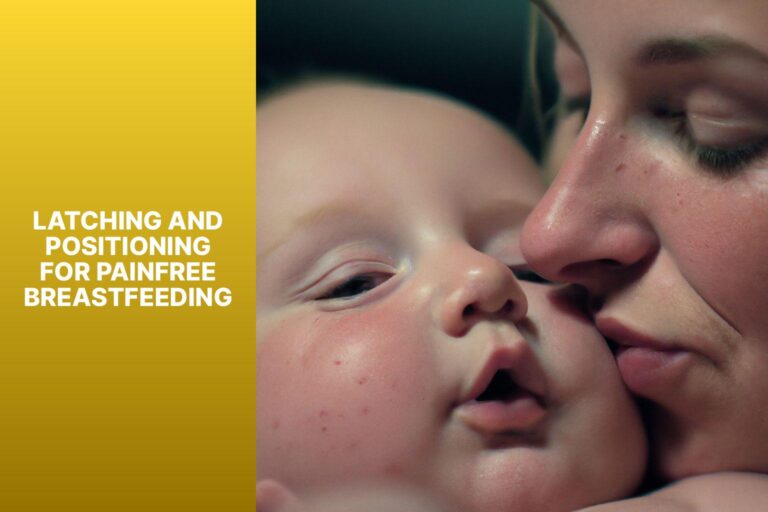Breastfeeding in Side-Lying Position: Tips for Nighttime Comfort
Breastfeeding is a beautiful and intimate bonding experience between a mother and her baby. The side-lying position is one of the many breastfeeding positions that can provide comfort and ease, especially during nighttime feedings. This article will explore the benefits of side-lying breastfeeding, tips for getting comfortable in this position, steps to achieve a proper latch, and tips specifically for nighttime breastfeeding. We will address common challenges such as engorgement, nipple pain, and leaking milk, providing solutions to make the breastfeeding journey more comfortable and enjoyable. By learning about and practicing the side-lying position, mothers can experience enhanced comfort and convenience while nurturing their little ones during nighttime feedings.
Benefits of Side-Lying Position for Breastfeeding
The side-lying position offers several benefits for breastfeeding mothers and their babies:
- Comfort: The side-lying position can provide greater comfort during nighttime feedings. It allows both the mother and baby to relax and find a comfortable position, reducing strain on the mother’s back, neck, and arms.
- Improved Milk Flow: The side-lying position can help improve milk flow. Gravity can assist in the flow of milk, allowing it to move more easily from the breast to the baby’s mouth.
- Extended Rest: Breastfeeding in the side-lying position allows mothers to rest during nighttime feedings. This position can help minimize the disruption of sleep, allowing both the mother and baby to fall back asleep more easily.
- Bonding: The side-lying position encourages close physical contact between the mother and baby, promoting bonding and emotional connection.
- Mobility: Breastfeeding in the side-lying position allows mothers to easily switch between breasts without needing to sit up or reposition themselves. This can be especially helpful during nighttime feedings when both mother and baby may be drowsy.
- Pain Relief: For mothers who may be experiencing discomfort after childbirth, such as sore nipples or perineal pain, the side-lying position can provide relief by reducing pressure on sensitive areas.
- Promotes Relaxation: The side-lying position promotes relaxation for both the mother and baby. The calming effect can lead to a more peaceful and enjoyable breastfeeding experience.
- Supports Milk Production: The side-lying position allows for frequent nighttime feedings, which can help stimulate milk production and ensure an adequate milk supply.
- Safe Co-Sleeping Option: Breastfeeding in the side-lying position can be a safe option for co-sleeping families. Following safe co-sleeping guidelines, such as using a firm mattress and removing pillows or blankets from the immediate sleep area, can provide a secure environment for breastfeeding in this position.
The side-lying position offers numerous benefits, making it a popular choice for nighttime breastfeeding. It’s important for each mother to find the position that works best for her and her baby, considering factors such as comfort, safety, and individual preferences.
How to Get Comfortable in the Side-Lying Position
Getting a good night’s sleep while breastfeeding can be a challenge, especially when trying to find a comfortable position. In this section, we’ll explore tips and tricks for getting comfortable in the side-lying position. From choosing the right mattress and pillows to arranging your sleeping area, we’ll help you create a cozy environment that promotes breastfeeding ease and nighttime comfort. Rest assured, these practical strategies will make your breastfeeding journey a whole lot more enjoyable.
Choosing the Right Mattress and Pillows
- Choosing the right mattress and pillows is crucial for achieving comfort while breastfeeding in the side-lying position.
- Consider a medium-firm mattress that provides adequate support to prevent sinking too deeply into the bed.
- Opt for a pillow that is firm enough to keep your head and neck aligned with your body. This helps maintain a neutral spine position.
- Choose a pillow that is the right height, ensuring that your baby’s head is level with your breast.
- Look for a pillow with a washable cover to keep it clean and hygienic.
- If you prefer a specially designed breastfeeding pillow, make sure it provides proper support and comfort for both you and your baby.
- Consider using additional pillows to support your back and legs, ensuring optimal comfort while lying on your side.
- Test out different pillow configurations to find the one that works best for your comfort and breastfeeding needs.
By choosing the right mattress and pillows, you can enhance your comfort and promote a successful breastfeeding experience in the side-lying position.
Arranging Your Sleeping Area
- Arranging Your Sleeping Area
- Clear the clutter from your bedside table to create a clean and organized space.
- Place a small lamp or night light near your bed for easy visibility during nighttime feedings.
- Have a comfortable chair or breastfeeding pillow nearby for added support while nursing.
- Keep a water bottle and snacks within reach to stay hydrated and nourished during nighttime breastfeeding sessions.
- Use blackout curtains or blinds to create a dark and peaceful environment conducive to sleep.
- Keep a soft and cozy blanket within reach for added comfort during feedings or when you need extra warmth.
- Have a nursing cover or privacy screen nearby if you prefer additional privacy while breastfeeding.
- Keep a burp cloth or muslin cloth handy to quickly clean up any spills or messes.
- Ensure that your bed is at a comfortable height for easy access and that the mattress is supportive and of good quality.
- Consider using a body pillow or pregnancy pillow to provide support and alleviate any discomfort while sleeping in a side-lying position for breastfeeding.
- Keep a baby monitor close by so you can easily check on your little one without leaving your bed.
- Create a calming and relaxing ambiance in your sleeping area with essential oils or soothing sounds to promote restful sleep for both you and your baby.
Steps to Achieve a Proper Latch
Follow these steps to achieve a proper latch while breastfeeding in a side-lying position:
- Positioning: Lie on your side with your baby facing you, tummy to tummy. Use pillows or cushions to support your back and knees, ensuring a comfortable and aligned position.
- Support Your Breast: Use your free hand to shape and support your breast. Gently lift and compress the breast to make it easier for your baby to latch.
- Nose-to-Nipple Alignment: Bring your baby’s nose to the level of your nipple, ensuring proper alignment. This helps your baby open their mouth wide and take in a good portion of the areola along with the nipple.
- Wait for a Wide Mouth: Before latching, wait for your baby to open their mouth wide. This indicates that they are ready to latch deeply onto the breast.
- Guide the Latch: Guide your baby’s head towards your breast and gently bring them onto the nipple. Aim to have your baby take in a large portion of the areola, as this helps with effective milk transfer and prevents nipple soreness.
- Listen for Swallowing: As your baby latches and begins to breastfeed, listen for the sound of swallowing. This indicates that your baby is effectively transferring milk.
- Check Comfort: Pay attention to your comfort level while breastfeeding in the side-lying position. Adjust pillows or cushions as needed to provide adequate support and prevent strain on your neck, shoulders, and back.
- Switch Sides: After a feeding session, you may choose to switch sides by rolling to the other side. Repeat the steps to achieve a proper latch on the opposite breast.
- Monitor Your Baby: Observe your baby’s feeding cues and monitor their weight gain to ensure they are getting enough milk. Consult with a lactation consultant or healthcare provider if you have any concerns.
Remember, practice and patience are key to mastering the side-lying breastfeeding position and achieving a proper latch. With time, you and your baby will become more comfortable and efficient in this breastfeeding position.
Tips for Nighttime Breastfeeding in Side-Lying Position
When it comes to breastfeeding during nighttime, finding the most comfortable position is crucial. In this section, we’ll uncover some valuable tips that can make nighttime breastfeeding in a side-lying position a breeze. From prioritizing safety to using the right nursing pillow and exploring various positions, we’ll ensure that both you and your baby have a relaxed and enjoyable feeding experience. So, let’s dive in and discover the secrets to nighttime comfort while breastfeeding!
Keep Safety in Mind
When breastfeeding in the side-lying position, it is crucial to keep safety in mind. Here are some tips to ensure a safe breastfeeding experience:
1. Choose a firm and supportive mattress: Keeping safety in mind, opt for a firm mattress that provides stability and reduces the risk of suffocation for both you and your baby.
2. Clear your sleeping area: To prioritize safety, remove any pillows, blankets, or clutter that could potentially obstruct your baby’s breathing. It is essential to have a sleeping area that is free from hazards.
3. Use a nursing pillow: Ensure safety by using a nursing pillow. It will provide support and keep your baby in a secure and comfortable position while breastfeeding.
4. Keep your baby’s head elevated: To reduce the risk of choking, it is important to keep your baby’s head slightly elevated while breastfeeding in the side-lying position. You can achieve this by placing a small towel or blanket under your baby’s head.
5. Avoid falling asleep completely: Keeping safety in mind, it is vital to stay awake and alert while breastfeeding in the side-lying position. This will prevent any accidental rolling onto your baby. If you feel drowsy, it is safer to breastfeed in a seated position.
Remember, safety should always be the top priority when breastfeeding in the side-lying position. By following these guidelines and keeping safety in mind, you can ensure a comfortable and secure breastfeeding experience for both you and your baby.
Incorporating these safety measures will help create a secure environment for breastfeeding in the side-lying position. By prioritizing safety and keeping it in mind, you can enjoy a peaceful and nurturing breastfeeding experience with your little one.
Use a Nursing Pillow
When breastfeeding in the side-lying position, incorporating the use of a nursing pillow can naturally provide added support and comfort for both you and your baby.
- Elevated support: By utilizing a nursing pillow, you can elevate your baby to the correct height, aligning their mouth with your nipple for an optimal latch.
- Better positioning: The nursing pillow helps maintain proper alignment of your baby’s body during breastfeeding, reducing strain on your neck, shoulders, and back.
- Hands-free feeding: By employing the use of a nursing pillow, you can free up your hands to support your breast or engage in other activities like reading or using your phone.
- Increased relaxation: Incorporating the nursing pillow provides a stable and comfortable surface, allowing you to relax and fully enjoy the bonding experience with your baby.
- Versatile and adjustable: Nursing pillows come in various shapes and sizes, enabling you to find one that suits your specific needs. They often have adjustable straps or cushions that can be modified to achieve the best positioning for you and your baby.
To make the most of using a nursing pillow, ensure it is firm enough to provide adequate support. Remember to always supervise your baby while breastfeeding in the side-lying position, even when utilizing a nursing pillow.
Experiment with Different Positions
When it comes to breastfeeding, it is important to experiment with different positions in order to find the most comfortable and effective one for both you and your baby. Here are a few suggestions to try:
- Try lying on your side with your baby facing you. This position allows your baby to latch onto your breast from the side, creating a side-lying cradle hold. It can provide a more relaxed and comfortable feeding experience.
- An alternative position to consider is the football hold in the side-lying position. In this position, you can support your baby’s head with one hand while they latch onto your breast. This position can be particularly helpful if you have a larger chest or if your baby has difficulty latching.
- Another option is to lie on your side with your baby facing away from you, which is commonly referred to as the “koala hold.” This position can be beneficial if you have a forceful letdown or if your baby struggles with reflux. It allows gravity to assist in keeping breast milk down.
- Don’t forget to switch sides during breastfeeding. It is important to alternate between the left and right sides to ensure that both breasts are adequately stimulated and drained. This can help maintain a good milk supply and prevent issues like blocked ducts.
Remember, every breastfeeding journey is unique, and what works for one person may not work for another. Trust your instincts, listen to your baby’s cues, and don’t hesitate to seek guidance from a lactation consultant if needed.
Stay Relaxed
To stay relaxed while breastfeeding in the side-lying position, it is important to prioritize your comfort and well-being. Take deep breaths and find a comfortable position to help unwind and create a sense of ease during this special bonding time with your baby. Release tension in your muscles and promote relaxation by practicing techniques such as progressive muscle relaxation or meditation. Create a peaceful environment in your sleeping area to enhance relaxation. Consider dimming the lights and playing soft, calming music to stay relaxed. By focusing on the present moment and letting go of any worries or stress, you can fully embrace the calming benefits of the side-lying position while breastfeeding.
Common Challenges and Solutions
Breastfeeding at night can have its challenges, but worry not! This section explores common hurdles and their solutions, so you can find nighttime comfort while nursing your little one. From engorgement to nipple pain and leaking milk, we’ll uncover practical tips and tricks to help you navigate through these obstacles. So rest assured, with our handy advice, you’ll be well-equipped to tackle any breastfeeding challenges that come your way, allowing you to have a peaceful and nurturing nighttime experience.
Engorgement
HTML
is a common issue that breastfeeding mothers may face. Here are some tips to help alleviate engorgement:
- 1. Breastfeed frequently: Engorgement often occurs when the breasts are not emptied regularly. Aim to breastfeed or express milk every 2-3 hours to prevent engorgement.
- 2. Apply warm compresses: Placing a warm compress on the breasts before breastfeeding can help to soften the breast tissue and make it easier for the baby to latch.
- 3. Use cold compresses: After breastfeeding, applying a cold compress to the breasts can help reduce any swelling and discomfort associated with engorgement.
- 4. Hand express or pump: If the breasts are too full and the baby is having difficulty latching, hand expressing or pumping a small amount of milk can help to relieve the pressure and make breastfeeding easier.
- 5. Avoid tight clothing and bras: Wearing loose-fitting clothing and a well-fitted bra can prevent constriction of the breasts, allowing milk to flow freely and reducing the risk of engorgement.
- 6. Massage the breasts: Gently massaging the breasts in a circular motion can help to stimulate milk flow and relieve engorgement.
- 7. Seek support: If engorgement persists or becomes painful, it’s important to seek support from a lactation consultant or healthcare provider who can provide guidance and assistance.
By following these tips, breastfeeding mothers can effectively manage engorgement and ensure a comfortable breastfeeding experience.
Nipple Pain
- Nipple pain, a common concern for breastfeeding mothers, can be addressed through various strategies.
- Ensuring the baby latches correctly onto the breast is crucial in preventing nipple pain.
- It is important to check for signs of tongue tie or lip tie in the baby, as these conditions can contribute to nipple pain.
- To soothe and heal sore nipples, it is advisable to use lanolin or other nipple creams.
- Harsh soaps or lotions should be avoided on the breasts as they can exacerbate nipple pain by drying out the skin.
- Experimenting with different breastfeeding positions can help find a more comfortable position that reduces nipple pain.
- If nipple pain persists, seeking help from a lactation consultant or healthcare provider is recommended, as there may be underlying issues causing the pain.
- Taking breaks between feedings to allow the nipples to rest and heal is essential.
- Proper latch and positioning during breastfeeding should be ensured, as improper latch can lead to nipple pain.
- Keeping the nipples dry and clean is essential in preventing infections, which can contribute to nipple pain.
Leaking Milk
- Experiencing leaking milk is a common and frustrating occurrence during breastfeeding. It can cause discomfort as well.
- To prevent leaking milk, it is essential to ensure a proper latch. A good latch allows the baby to efficiently extract milk from the breast, reducing the likelihood of excess milk accumulation.
- Applying gentle pressure on the non-nursed breast using your hand or a nursing pad is another helpful tip to prevent leaks. This gentle pressure can avoid unnecessary milk flow.
- Wearing a supportive bra can also minimize leaks. A well-fitting bra offers gentle compression and support to the breasts, reducing the chances of milk leakage.
- If leaks occur, using nursing pads can be beneficial. These pads absorb milk and prevent it from soaking through your clothing.
- It is important to remember that leaking milk is a normal part of breastfeeding and does not indicate any issue with your milk supply. In case of excessive or painful leaks, it is advisable to consult a lactation consultant or healthcare provider for further guidance and support.
Frequently Asked Questions
1. Is side lying breastfeeding safe for both the mother and baby?
Yes, side lying breastfeeding is considered safe for both the mother and the baby. It is a comfortable and convenient position, especially for nighttime feedings or after a cesarean section. However, it is important to remain awake and practice safe sleep practices to reduce the risk of sudden infant death syndrome (SIDS).
2. What are the benefits of side lying breastfeeding?
There are several benefits to side lying breastfeeding. It can provide comfort and relaxation for tired or sick mothers. It can also be helpful for mothers recovering from vaginal birth or a cesarean section, as it avoids putting pressure on painful areas. Side lying breastfeeding is also beneficial for mothers with larger breasts or those who find sitting up to breastfeed a strain.
3. How can I ensure a comfortable side lying breastfeeding position?
To ensure a comfortable side lying breastfeeding position, it is recommended to use a pillow or blanket for back support. The mother’s head and back should be in a straight line, and a pillow or arm can support the head. Placing a pillow between the knees can provide additional comfort. It may be necessary to lift the breast to the baby’s mouth to achieve a picture-perfect latch.
4. Can side lying breastfeeding help with clogged milk ducts?
Yes, side lying breastfeeding can help with clogged milk ducts. Nursing in different positions, including side lying, can help to clear clogged ducts and prevent further blockages. The position allows gravity to assist in the draining of the breast, promoting milk flow.
5. Is it safe to fall asleep while side lying breastfeeding?
No, it is not safe to fall asleep while side lying breastfeeding. Always remain awake and alert during feeding sessions to ensure the safety of the baby. After the feeding session, it is recommended to move the baby back to their separate sleep surface to reduce the risk of SIDS.
6. When should I seek support from a lactation professional or doctor?
If you have any concerns or breastfeeding-related issues, it is recommended to seek support from a lactation consultant or doctor. They can provide guidance, address any difficulties you may be experiencing, and offer personalized advice to ensure a smooth breastfeeding journey.










